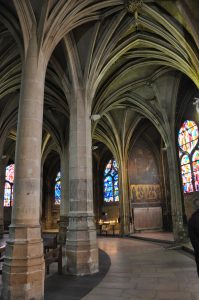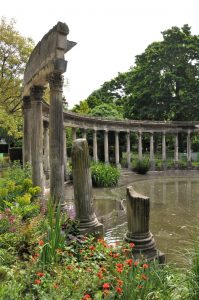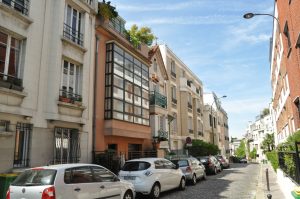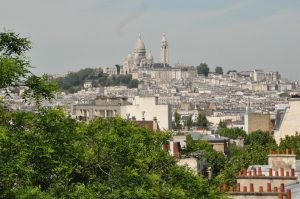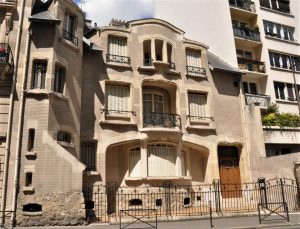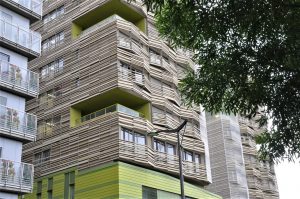“Alistair Horne, Vivid War Historian and Onetime British Spy, Dies at 91.”
The headline in today’s New York Times would have caught my eye any morning. Right now, however, I am up to page 306 of Horne’s Seven Ages of Paris, engrossed in his narrative of the years leading to World War I. It’s a wonderful read—and has been a welcome companion on this visit to the City of Light. In fact, I had been planning on sending a fan letter.
Also with us is the ubiquitous but useful Paris in the DK Eyewitness Travel series—whose very good city map was dropped in the Café le Dante on day 7. Darned careless on my part. I don’t know that DK makes better travel guides than Lonely Planet or Fodor’s or any other publisher, but they include a map that is vastly superior to the one provided in Rick Steves’ guide. I know this because during the fruitless search for the DK map I lost I found Rick Steves’ map on the pavement outside Église Saint-Séverin. Better than nothing, but not good.
At any rate, the guide includes “Eight Guided Walks,” each purportedly under two miles in length and 90 minutes in duration. On Saturday morning, day 5 of our visit, we ambled southwest down rue Legendre, from our apartment in the 17ème toward Parc Monceau in the 8ème. The architecture changed as we walked, the gritty but gentrifying streets of Batignolles giving way to Belle Époque hôtels and spacious apartment buildings in the upscale 8ème. In the Parc Monceau My Dear One read aloud, identifying points of interest.
We didn’t complete the walk, pausing for lunch at Le Monceau on Boulevard Haussmann, one of the few eateries open on a Saturday, then exploring the nearby Musée Jacquemart-André. How different these quiet streets were from our own lively quartier. Lives here seemed private, shuttered.
Having enjoyed our “90-Minute Walk around Parc Monceau,” we set out a couple days later for the walk in Buttes-Chaumont. Do note that none of these walks are really ninety minutes long and they may claim to come in under two miles, and maybe that is true, but properly done with a break for a respectable Parisian lunch, one should allocate no less than three hours to each. Better yet, the best part of the day, for picture-taking, window shopping and periodic refreshment.
Buttes-Chaumont in the 19ème is one of the great park projects ordered by Napoleon III as part of the renovations carried out by Baron Haussmann in the 1860s. Shaped somewhat like a vulture’s head whose eye is the mountain surrounded by water, the terrain was transformed from naked stone quarries to a series of steep slopes ornamented with man-made lakes and rugged tors. There is a note that “The walk is quite strenuous with many steps and takes in a charming micro-village…perched high above the city.” “Strenuous” is not an overstatement. Wear your most comfortable walking shoes.
That little “micro-village,” the Butte Bergeyre, offered a sense of how much Paris is a patchwork of development. In Seven Ages of Paris, Horne describes the emergence of the city from Roman Lutetia, a settlement built on a few muddy islands in the Seine to a walled fortress and keep on the Right Bank, mainly in the area of the Marais, to a sprawling Renaissance metropolis and finally the City of Light with its monuments and boulevards.
While the architecture of the Second Empire and Third Republic was much in evidence, a more modern flavor was present. On the Butte Bergeyre, Art Nouveau curves abut Art Deco angles and a small vineyard reminds me that these neighborhoods, in the lifetimes of my grandparents (born between 1892 and 1898), were certainly suburban—and in parts truly rural. As I walked down the narrow streets of the Butte, noting the long, steep stairs that provided pedestrian access, I also noticed that many of the homes included garages. This development was built in the 1920s for people of means—people who owned automobiles. The individuality of the houses suggested that these were custom-designed for clients, not built on spec for an expanding bourgeoisie.
Our final “90-minute walk” took us south and west to Auteuil in the 16ème, a place happily much flatter than the regions north and east, tucked in between the Seine and the exurban spread of the Bois de Boulogne. It is near enough to the Bois that a sign points that-a-way to Roland Garros stadium. Auteuil is still regarded as a village (quite a posh village) and that is the atmosphere we found.
The center spreads out from Notre-Dame d’Auteuil, a neo-Romanesque structure that replaced a much earlier medieval structure. John and Abigail Adams, prior to their habitation in the White House, lived in a grand neoclassical hôtel three short blocks down rue d’Auteuil from 1778-79 with their family—earning that elegant building the right to boast on a plaque that this had been the residence of two presidents of the United States. Just across the street is Le Mouton Blanc where Molière and his circle of writers and actors ate and drank some four and a half centuries ago. Been cleaned up since then and they offer a spectacular lapin à la moutarde with a side of fresh noodles.
The modernism of the Butte Bergeyre is even more pronounced in Auteuil. The lengthy rue La Fontaine competes with Brussels as a display of Art Nouveau design, and here and there sleek Art Deco apartments break that rhythm. The most spectacular works are by Hector Guimard (1867-1942), the architect of the Paris Metro signs, railings and waiting rooms. At number 14 is the Castel Béranger, an apartment building completed in 1898.
Around the corner on rue de l’Assomption, structures of more recent vintage appear. Finally, a few minutes from the Jasmin Metro stop, design catapulted forward to the International Style. A row of houses designed by Robert Mallet-Stevens (1886-1945) once sheltered architects, designers, artists and their modern-minded clients. At the end of a small cul-de-sac is the holy grail of modernist architecture: the Villa Roche and the Villa Jeanneret, both the work of Le Corbusier, born Charles Édouard Jeanneret (1887-1965).
Back home in Batignolles, we continued with our vacation, making unfamiliar corners of our neighborhood known to us, hewing to the patterns established on day one: rising, shower and a quick run for baguette traditionelle and pain aux raisins, a check of email and the news on CNN or BBC, a walk to the bus Metro, most often Line 13, the “light-blue line,” and on to wherever. I began to notice, though, the number of quite lovely buildings around us. Some looked like apartments, others like townhomes, many with an Art Nouveau flavor. Almost all of them were signed and dated. Batignolles must have been under construction for most of the 1890s and 1910s.
Today cranes reach skyward over building sites and recent structures of imaginative design border the Parc Martin Luther King Jr. and the Square des Batignolles. I am sentimental about the Paris of the past, and I want to preserve that dreamy, vaguely 1920s fantasy of the Lost Generation of my imagination.
But Paris has always been a place of change. Alistair Horne wrote about that change. Each building documents that change. Each arrondissement and quartier is shaped by that change.

